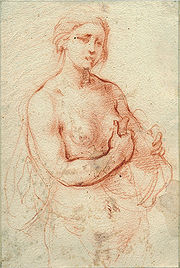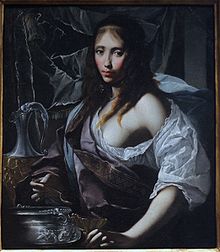
Francesco Furini
Encyclopedia


Italy
Italy , officially the Italian Republic languages]] under the European Charter for Regional or Minority Languages. In each of these, Italy's official name is as follows:;;;;;;;;), is a unitary parliamentary republic in South-Central Europe. To the north it borders France, Switzerland, Austria and...
Baroque
Baroque
The Baroque is a period and the style that used exaggerated motion and clear, easily interpreted detail to produce drama, tension, exuberance, and grandeur in sculpture, painting, literature, dance, and music...
painter of Florence
Florence
Florence is the capital city of the Italian region of Tuscany and of the province of Florence. It is the most populous city in Tuscany, with approximately 370,000 inhabitants, expanding to over 1.5 million in the metropolitan area....
.
His early training was by Matteo Rosselli
Matteo Rosselli
Matteo Rosselli was an Italian painter of the late Florentine Counter-Maniera and early Baroque. He is best known however for his highly-populated grand-manner historical paintings.-Biography:...
(whose other pupils include Lorenzo Lippi
Lorenzo Lippi
Lorenzo Lippi was an Italian painter and poet.Born in Florence, he studied painting under Matteo Rosselli. Both Baldassare Franceschini and Francesco Furini were also apprenticed with Rosselli...
and Baldassare Franceschini
Baldassare Franceschini
thumb|Portrait of Cardinal [[Gian Carlo de' Medici]].Baldassare Franceschini was an Italian late Baroque painter active mainly around Florence...
), though Furini is also described as influenced by Domenico Passignano
Domenico Passignano
Domenico Passignano , born Cresti or Crespi, was an Italian painter of a late-Renaissance or Contra-Maniera style that emerged in Florence towards the end of the 16th century.- Biography :...
and Giovanni Biliverti
Giovanni Biliverti
Giovanni Biliverti was an Italian painter of the late-Mannerism and early-Baroque period, active mainly in his adoptive city of Florence, as well as Rome. His father had been born in was born at Maastricht. Also known as Giovanni Biliverti. He was the son of the Flemish painter in Florence,...
(Cantelli 1972). He befriended Giovanni da San Giovanni
Giovanni da San Giovanni
Giovanni da San Giovanni , also known as Giovanni Mannozzi, was an Italian painter of the early Baroque period.-Biography:...
. Traveling to Rome
Rome
Rome is the capital of Italy and the country's largest and most populated city and comune, with over 2.7 million residents in . The city is located in the central-western portion of the Italian Peninsula, on the Tiber River within the Lazio region of Italy.Rome's history spans two and a half...
in 1619, he also would have been exposed to the influence of Caravaggio
Caravaggio
Michelangelo Merisi da Caravaggio was an Italian artist active in Rome, Naples, Malta, and Sicily between 1593 and 1610. His paintings, which combine a realistic observation of the human state, both physical and emotional, with a dramatic use of lighting, had a formative influence on the Baroque...
and his followers. Among his pupils are Simone Pignoni
Simone Pignoni
Simone Pignoni was an Italian painter of the Baroque period.He apprenticed with Fabrizio Boschi, then with the more academic and puritanical Domenico Passignano, and finally with Francesco Furini. He is best known for painting in a style reminiscent of the morbidly sensual Furini. Reflective of...
(1611–98) and Giovanni Battista Galestruzzi
Giovanni Battista Galestruzzi
Giovanni Battista Galestruzzi was an Italian painter and etcher of the Baroque period. Born in Florence, he was a pupil of the painter Francesco Furini, then moved to Rome, where he joined the Accademia di San Luca in 1652. He was an accomplished etcher and produced works for Leonardo Agostini’s...
. At the age of forty, he became a priest for the parish of Sant'Ansano in Mugello.
Furini's work reflects the tension faced by the conservative, mannerist
Mannerism
Mannerism is a period of European art that emerged from the later years of the Italian High Renaissance around 1520. It lasted until about 1580 in Italy, when a more Baroque style began to replace it, but Northern Mannerism continued into the early 17th century throughout much of Europe...
style of Florence when confronting then novel Baroque
Baroque
The Baroque is a period and the style that used exaggerated motion and clear, easily interpreted detail to produce drama, tension, exuberance, and grandeur in sculpture, painting, literature, dance, and music...
styles. He is a painter of biblical and mythological set-pieces with a strong use of the misty sfumato
Sfumato
Sfumato is one of the four canonical painting modes of the Renaissance .The most prominent practitioner of sfumato was Leonardo da Vinci, and his famous painting of the Mona Lisa exhibits the technique. Leonardo da Vinci described sfumato as "without lines or borders, in the manner of smoke or...
technique. In the 1630s, when he became a priest, his style paralleled that of Guido Reni
Guido Reni
Guido Reni was an Italian painter of high-Baroque style.-Biography:Born in Bologna into a family of musicians, Guido Reni was the son of Daniele Reni and Ginevra de’ Pozzi. As a child of nine, he was apprenticed under the Bolognese studio of Denis Calvaert. Soon after, he was joined in that...
.
Freedberg describes Furini's style as filled with "morbid sensuality". His frequent use of disrobed females is discordant with his excessive religious sentimentality, and his polished stylization and poses are at odds with his aim of expressing highly emotional states. His stylistic choices did not go unnoticed by more puritanical contemporary biographers like Baldinucci
Filippo Baldinucci
Filippo Baldinucci was an Italian art historian and biographer.-Life:Baldinucci is considered among the most significant Florentine biographers/historians of the artists and the arts of the Baroque period...
. Pignoni also mirrored this style in his works.
One of his masterpieces, and not reflective of the style of his canvases, is the airy fresco in Palazzo Pitti
Palazzo Pitti
The Palazzo Pitti , in English sometimes called the Pitti Palace, is a vast mainly Renaissance palace in Florence, Italy. It is situated on the south side of the River Arno, a short distance from the Ponte Vecchio...
, where on order of Ferdinando II de Medici, between 1639–1642, Furini frescoed two large lunettes depicting the Platonic Academy of Careggi
Villa Medici at Careggi
The Villa Medici at Careggi is a patrician villa in the hills near Florence, Tuscany, central Italy.-History:The villa was among the first of a number of Medici villas, notable as the site of the Platonic academy founded by Cosimo de' Medici, who died at the villa in 1464...
and the Allegory of the Death of Lorenzo the Magnificent. The frescoes can be seen as a response to Pietro da Cortona
Pietro da Cortona
Pietro da Cortona, by the name of Pietro Berrettini, born Pietro Berrettini da Cortona, was the leading Italian Baroque painter of his time and also one of the key architects in the emergence of Roman Baroque architecture. He was also an important decorator...
, who was at work in the palazzo during these years (Cantelli 1972).
In Robert Browning's
Robert Browning
Robert Browning was an English poet and playwright whose mastery of dramatic verse, especially dramatic monologues, made him one of the foremost Victorian poets.-Early years:...
series of poems titled Parleyings with certain people of importance in their day, the poet envisions an explanation by Furini that refutes the published assertion by Filippo Baldinucci
Filippo Baldinucci
Filippo Baldinucci was an Italian art historian and biographer.-Life:Baldinucci is considered among the most significant Florentine biographers/historians of the artists and the arts of the Baroque period...
that (on his deathbed) he had ordered all his nude paintings be destroyed. For Browning, Furini's disrobement of his subjects is emblematic of a courageous search for the hidden truth. Modern research has demonstrated that Furini did not abandon his sensual painting subjects on entering the priesthood.
Furini was rediscovered in the early 20th century by Arturo Stanghellini. His scantily documented career was sketched by Elena Toesca (Furini, 1950) and brought into focus with an exhibition of his drawings at the Uffizi
Uffizi
The Uffizi Gallery , is a museum in Florence, Italy. It is one of the oldest and most famous art museums of the Western world.-History:...
, 1972.
Anthology of works
- Cephalus and Aurora (before 1626, Museo de Arte, Ponce)
- Hylas and the Nymphs, (shortly before 1633, Galleria Furini, Florence)
- Faith, (1638, Palazzo PittiPalazzo PittiThe Palazzo Pitti , in English sometimes called the Pitti Palace, is a vast mainly Renaissance palace in Florence, Italy. It is situated on the south side of the River Arno, a short distance from the Ponte Vecchio...
) - St John the Evangelist, (1630s, Musée des Beaux-Arts, Lyon)
- The Birth of Rachel, (Alte PinakothekAlte PinakothekThe Alte Pinakothek is an art museum situated in the Kunstareal in Munich, Germany. It is one of the oldest galleries in the world and houses one of the most famous collections of Old Master paintings...
, Munich) - Judith and Holofernes, (1636, Galleria Nazionale d'Arte AnticaGalleria Nazionale d'Arte AnticaThe Galleria Nazionale d'Arte Antica, or National Gallery of Ancient Art, is an art gallery in Rome, Italy, located on two sites: the Palazzo Barberini and the Palazzo Corsini....
, Rome) - Lot and his Daughters, (Museo del PradoMuseo del PradoThe Museo del Prado is the main Spanish national art museum, located in central Madrid. It features one of the world's finest collections of European art, from the 12th century to the early 19th century, based on the former Spanish Royal Collection, and unquestionably the best single collection of...
, Madrid) - Bound Andromeda, (HermitageHermitage MuseumThe State Hermitage is a museum of art and culture in Saint Petersburg, Russia. One of the largest and oldest museums of the world, it was founded in 1764 by Catherine the Great and has been opened to the public since 1852. Its collections, of which only a small part is on permanent display,...
, St Petersburg) - Bound Andromeda, (National Galleries, Budapest, Hungary)
- Crucifixion with angels, Saint Bartholemew, Saint John, and Mary Magdalen, (San Bartolomeo, Todiano in Preci)
- Penitent Magdalen
- Frescoes, Salone, Palazzo Pitti (documented 1639-42, Museo degli Argenti)
- The Three Graces, (Hermitage, St Petersburg)
- Saint Sebastian (Schleissheim PalaceSchleissheim PalaceThe Schleissheim Palace actually comprises three palaces in a grand baroque park in the village of Oberschleißheim near Munich, Bavaria, Germany. The palace was the summer residence of the rulers of Bavaria.-Old Schleissheim Palace:...
)

